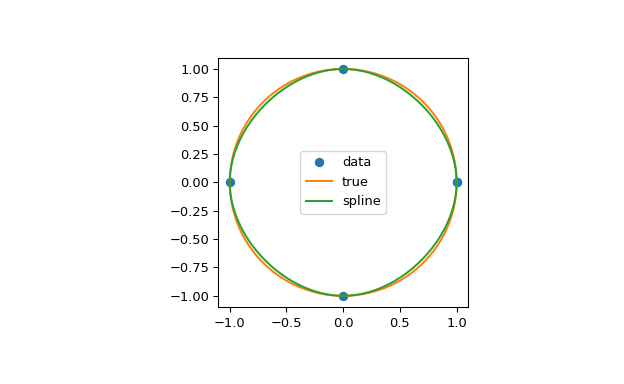
Interpolate data with a piecewise cubic polynomial which is twice continuously differentiable [1]. The result is represented as a PPoly instance with breakpoints matching the given data.
Parameters : x array_like, shape (n,)
1-D array containing values of the independent variable. Values must be real, finite and in strictly increasing order.
y array_like
Array containing values of the dependent variable. It can have arbitrary number of dimensions, but the length along axis (see below) must match the length of x . Values must be finite.
axis int, optional
Axis along which y is assumed to be varying. Meaning that for x[i] the corresponding values are np.take(y, i, axis=axis) . Default is 0.
bc_type string or 2-tuple, optional
Boundary condition type. Two additional equations, given by the boundary conditions, are required to determine all coefficients of polynomials on each segment [2].
If bc_type is a string, then the specified condition will be applied at both ends of a spline. Available conditions are:
If bc_type is a 2-tuple, the first and the second value will be applied at the curve start and end respectively. The tuple values can be one of the previously mentioned strings (except ‘periodic’) or a tuple (order, deriv_values) allowing to specify arbitrary derivatives at curve ends:
If bool, determines whether to extrapolate to out-of-bounds points based on first and last intervals, or to return NaNs. If ‘periodic’, periodic extrapolation is used. If None (default), extrapolate is set to ‘periodic’ for bc_type='periodic' and to True otherwise.
Attributes : x ndarray, shape (n,)
Breakpoints. The same x which was passed to the constructor.
c ndarray, shape (4, n-1, …)
Coefficients of the polynomials on each segment. The trailing dimensions match the dimensions of y, excluding axis . For example, if y is 1-d, then c[k, i] is a coefficient for (x-x[i])**(3-k) on the segment between x[i] and x[i+1] .
axis int
Interpolation axis. The same axis which was passed to the constructor.
Evaluate the piecewise polynomial or its derivative.
Construct a new piecewise polynomial representing the derivative.
Construct a new piecewise polynomial representing the antiderivative.
Compute a definite integral over a piecewise polynomial.
Find real roots of the piecewise polynomial.
Akima 1D interpolator.
PCHIP 1-D monotonic cubic interpolator.
Piecewise polynomial in terms of coefficients and breakpoints.
Parameters bc_type and extrapolate work independently, i.e. the former controls only construction of a spline, and the latter only evaluation.
When a boundary condition is ‘not-a-knot’ and n = 2, it is replaced by a condition that the first derivative is equal to the linear interpolant slope. When both boundary conditions are ‘not-a-knot’ and n = 3, the solution is sought as a parabola passing through given points.
When ‘not-a-knot’ boundary conditions is applied to both ends, the resulting spline will be the same as returned by splrep (with s=0 ) and InterpolatedUnivariateSpline , but these two methods use a representation in B-spline basis.
Added in version 0.18.0.
Carl de Boor, “A Practical Guide to Splines”, Springer-Verlag, 1978.
Try it in your browser!In this example the cubic spline is used to interpolate a sampled sinusoid. You can see that the spline continuity property holds for the first and second derivatives and violates only for the third derivative.
>>> import numpy as np >>> from scipy.interpolate import CubicSpline >>> import matplotlib.pyplot as plt >>> x = np.arange(10) >>> y = np.sin(x) >>> cs = CubicSpline(x, y) >>> xs = np.arange(-0.5, 9.6, 0.1) >>> fig, ax = plt.subplots(figsize=(6.5, 4)) >>> ax.plot(x, y, 'o', label='data') >>> ax.plot(xs, np.sin(xs), label='true') >>> ax.plot(xs, cs(xs), label="S") >>> ax.plot(xs, cs(xs, 1), label="S'") >>> ax.plot(xs, cs(xs, 2), label="S''") >>> ax.plot(xs, cs(xs, 3), label="S'''") >>> ax.set_xlim(-0.5, 9.5) >>> ax.legend(loc='lower left', ncol=2) >>> plt.show()

In the second example, the unit circle is interpolated with a spline. A periodic boundary condition is used. You can see that the first derivative values, ds/dx=0, ds/dy=1 at the periodic point (1, 0) are correctly computed. Note that a circle cannot be exactly represented by a cubic spline. To increase precision, more breakpoints would be required.
>>> theta = 2 * np.pi * np.linspace(0, 1, 5) >>> y = np.c_[np.cos(theta), np.sin(theta)] >>> cs = CubicSpline(theta, y, bc_type='periodic') >>> print("ds/dx= ds/dy= ".format(cs(0, 1)[0], cs(0, 1)[1])) ds/dx=0.0 ds/dy=1.0 >>> xs = 2 * np.pi * np.linspace(0, 1, 100) >>> fig, ax = plt.subplots(figsize=(6.5, 4)) >>> ax.plot(y[:, 0], y[:, 1], 'o', label='data') >>> ax.plot(np.cos(xs), np.sin(xs), label='true') >>> ax.plot(cs(xs)[:, 0], cs(xs)[:, 1], label='spline') >>> ax.axes.set_aspect('equal') >>> ax.legend(loc='center') >>> plt.show()

>>> cs = CubicSpline([0, 1], [0, 1], bc_type=((1, 0), (1, 3))) >>> x = np.linspace(0, 1) >>> np.allclose(x**3, cs(x)) True